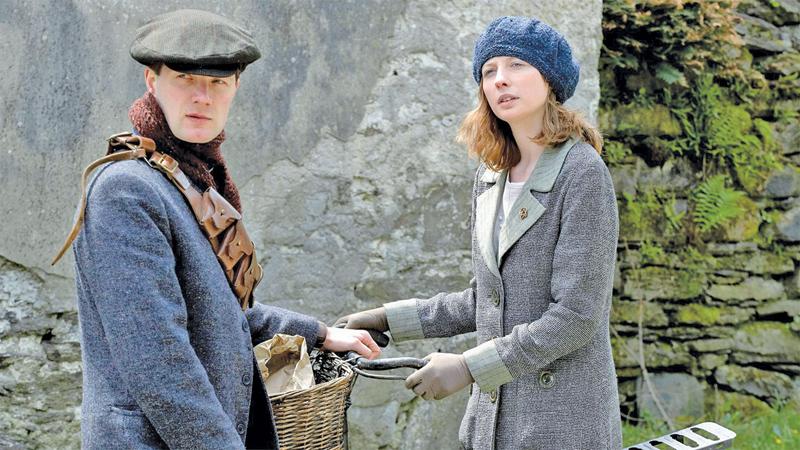
The wind that shakes the barley is a 2006 war drama film directed by Ken Loach, set during the Irish War of Independence (1919–1921) and the Irish Civil War (1922–1923). Written by long-time Loach collaborator Paul Laverty, this drama tells the fictional story of two County Cork brothers, Damien O’Donovan (Cillian Murphy) and Teddy O’Donovan (Pádraic Delaney), who join the Irish Republican Army to fight for Irish independence from the United Kingdom.
The film takes its title from Robert Dwyer Joyce’s The wind that shakes the barley which is a song set during the 1798 rebellion in Ireland and featured early in the film. The film is heavily influenced by Walter Macken’s 1964 novel The Scorching Wind.
Widely praised, the film won the Palme d’Or at the 2006 Cannes Film Festival. Loach’s biggest box office success to date, the film did well around the world and set a record in Ireland as the highest-grossing Irish-made independent film, until surpassed by The Guard.
Production
The film stars mostly Irish actors and was made by British director Ken Loach. It is an international co-production between companies in Ireland, the United Kingdom, Germany, Italy, Spain, France, Belgium, and Switzerland.
 The title derives from the song of the same name, The wind that shakes the barley, by 19th-century author Robert Dwyer Joyce. The song made the phrase ‘the wind that shakes the barley’ a motif in Irish republican song and poetry. Loach took some of the inspiration for Damian’s character from the memoirs of republican leader Ernie O’Malley.. University College ,Cork ,historian Donal O Drisceoil was Loach’s historical adviser on the film.
The title derives from the song of the same name, The wind that shakes the barley, by 19th-century author Robert Dwyer Joyce. The song made the phrase ‘the wind that shakes the barley’ a motif in Irish republican song and poetry. Loach took some of the inspiration for Damian’s character from the memoirs of republican leader Ernie O’Malley.. University College ,Cork ,historian Donal O Drisceoil was Loach’s historical adviser on the film.
The film was shot in various towns within County Cork during 2005, including Ballyvourney and Timoleague. Some filming took place in Bandon, County Cork: a scene was shot along North Main Street and outside a building next to the Court House. The ambush scene was shot on the mountains around Ballyvourney while the farmhouse scenes were filmed in Coolea. Damien’s execution scene was shot at Kilmainham Gaol in Dublin, where many leaders of the Irish rebellions were imprisoned and some executed by the British and latterly in 1923 by the Irish Free State.
Many of the extras in the film were drawn from local Scout groups, including Bandon, Togher and Macroom with veteran Scouter ,Martin Thompson in an important role. Many of the British soldiers seen in the film were played by members of the Irish Army Reserve, from local units.
Among the songs on the film’s soundtrack is Óró sé do bheatha abhaile, a 17th-century Irish Jacobite song whose lyrics the nationalist leader Pádraig Pearse changed to focus upon republican themes.
Reception
The wind that shakes the barley became the most popular, independent Irish film ever released in Ireland, earning €377,000 in its opening weekend and €2.7 million by August 2006.
The film received positive reviews from film critics. As of 19 August 2017, the review aggregator Rotten Tomatoes reported that 90 percent of critics gave the film positive reviews, based on 116 reviews. The website’s critical consensus reads, “Bleak and uncompromising, but director Ken Loach brightens his film with gorgeous cinematography and tight pacing, and features a fine performance from Cillian Murphy.”
Metacritic reported the film had an average score of 82 out of 100, based on 30 reviews.
The Daily Telegraph’s film critic described it as a “brave, gripping drama” and said that director Loach was “part of a noble and very English tradition of dissent”.
A Times film critic said that the film showed Loach “at his creative and inflammatory best”, and rated it as four out offive .
The Daily Record of Scotland gave it a positive review ( four out of five), describing it as “a dramatic, thought-provoking, gripping tale that, at the very least, encourages audiences to question what has been passed down in dusty history books.”
Michael Sragow of The Baltimore Sun named it the fifth best film of 2007, and Stephen Hunter of The Washington Post named it the seventh best film of 2007. Jim Emerson, Roger Ebert’s editor, gave the film a four star review, calling it “breathtakingly authentic”, and declared it ranked “among the best war films ever made.”
In a generally positive review, the Irish historian Brian Hanley suggested that the film might have dealt with the IRA’s relationship with the Protestant community, as one scene in its screenplay did.
The film also revived the debate on rival interpretations of Irish history.
****
Plot Summary:
In 1920, rural Ireland is the vicious battlefield of republican rebels against the British security forces and Irish Unionist population who oppose them, a recipe for mutual cruelty. Medical graduate Damien O’Donovan always gave priority to his socialist ideals and simply helping people in need. Just when he’s leaving Ireland to work in a highly reputed London hospital, witnessing gross abuse of commoners changes his mind. He returns and joins the local IRA brigade, commanded by his brother Teddy, and adopts the merciless logic of civil war, while Teddy mellows by experiencing first-hand endless suffering. When IRA leaders negotiate an autonomous Free State under the British Crown, Teddy defends the pragmatic best possible deal at this stage. Damien however joins the large seceding faction which holds that nothing less than a socialist republic will do. The result is another civil war, bloodily opposing former Irish comrades in arms, even the brothers.

